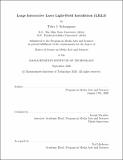| dc.contributor.advisor | Joseph Paradiso. | en_US |
| dc.contributor.author | Schoeppner, Tyler J. | en_US |
| dc.contributor.other | Program in Media Arts and Sciences (Massachusetts Institute of Technology) | en_US |
| dc.date.accessioned | 2021-01-06T18:33:31Z | |
| dc.date.available | 2021-01-06T18:33:31Z | |
| dc.date.copyright | 2020 | en_US |
| dc.date.issued | 2020 | en_US |
| dc.identifier.uri | https://hdl.handle.net/1721.1/129188 | |
| dc.description | Thesis: S.M., Massachusetts Institute of Technology, School of Architecture and Planning, Program in Media Arts and Sciences, September, 2020 | en_US |
| dc.description | Cataloged from student-submitted PDF version of thesis. | en_US |
| dc.description | Includes bibliographical references (pages 51-57). | en_US |
| dc.description.abstract | A large pseudo 3D display measuring 14x14x10 ft was built that used the pyramid Pepper's ghost to create the illusion of a floating 3D model. The Pepper's ghost was combined with laser projectors and anaglyph imaging to create more realistic 3D projections. Adding laser projectors worked well at removing the "ghostly", transparent characteristics of the projection often associated with the Pepper's ghost. The laser projectors were unable to display detailed images or textures and were limited to wireframes. A comparison of video and laser projectors found that only the laser projectors were capable of achieving good quality binocular disparity for the anaglyph images due to the high perceptual brightness of the laser images. A generalized framework for designing large 3D displays in public settings was proposed. | en_US |
| dc.description.statementofresponsibility | by Tyler J. Schoeppner. | en_US |
| dc.format.extent | 57 pages | en_US |
| dc.language.iso | eng | en_US |
| dc.publisher | Massachusetts Institute of Technology | en_US |
| dc.rights | MIT theses may be protected by copyright. Please reuse MIT thesis content according to the MIT Libraries Permissions Policy, which is available through the URL provided. | en_US |
| dc.rights.uri | http://dspace.mit.edu/handle/1721.1/7582 | en_US |
| dc.subject | Program in Media Arts and Sciences | en_US |
| dc.title | Large Interactive Laser Light-Field Installation (LILLI) | en_US |
| dc.title.alternative | LILLI | en_US |
| dc.type | Thesis | en_US |
| dc.description.degree | S.M. | en_US |
| dc.contributor.department | Program in Media Arts and Sciences (Massachusetts Institute of Technology) | en_US |
| dc.identifier.oclc | 1227278502 | en_US |
| dc.description.collection | S.M. Massachusetts Institute of Technology, School of Architecture and Planning, Program in Media Arts and Sciences | en_US |
| dspace.imported | 2021-01-06T18:33:30Z | en_US |
| mit.thesis.degree | Master | en_US |
| mit.thesis.department | Media | en_US |
